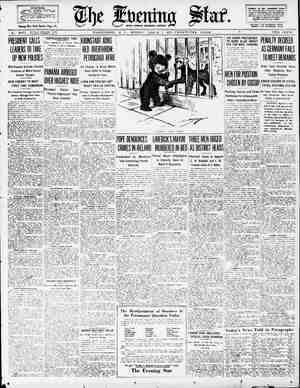The Nonpartisan Leader Newspaper, March 7, 1921, Page 7
You have reached the hourly page view limit. Unlock higher limit to our entire archive!
Subscribers enjoy higher page view limit, downloads, and exclusive features.
the automobilist who buys in Fargo pays'9 cents more and gets 27 cents more value. Other differences in the gasoline in the two cities are also important. The higher percentage of “light ends” in the Fargo gasoline means that a motor will start more easily, especially in cold weather. 'The fact that all the Fargo gasoline is distilled at 423 degrees means that little or none of it is wasted through the exhaust. (The average “end point” on all gasoline sold in the United States in 1920 was 456 degrees.) : : The Fargo gasoline tests are not the only ones that have been made. Three companies sell oil in North Dakota. During the ‘past year tests were made throughout the state with the following re- sults: No. of *Pect. .of $Pct. of Company tests gasoline kerosene Standard ... 81 64.6 . 354 Sinclair .... 22 62.9 37.1 Home ...... 41 63.7 36.3 *Distilled at 284 degrees. FResidue at 284 degrees. As was shown in the first table printed in this ARE GEESE article, the Standard in 1918 was selling a gasoline with 45.7 kerosene rgpge content, and in 1919 sold a gasoline with 48.9 kerosene range content. The . change to a gasoline with only 35.4 per cent kero- sene range content is a startling improvement, due altogether to the North Dakota law limiting the company to a 36 per cent kerosene range content, if they were to come under the one-fourth cent tax. TWO MILLIONS SAVINGS ESTIMATED BY OIL INSPECTION DEPARTMENT There -are in North Dakota between 90,000 and 100,000 automobiles. The Standard Oil company, as previously stated, handled 82 per cent of the gasoline sold in that state. On every gallon of gas- oline sold the consumer saves 1.8 cents as com- pared with the value of the gasoline sold across ‘the Red river at Moorhead, and approximately twice that much as compared with the value of the gasoline formerly sold in North Dakota. (There was 13% per cent more “original gasoline” in the Red Crown sold in 1920 than in the Red Crown sold in 1919.) ! Readers of the Leader who like to figure can es- BY JOHN M. BAER timate how much “gas” the average auto uses and then calculate for themselves how much this one law has saved North Dakota in one year. Burton L. Smith, author of the bulletin entitled “Fargo Gasoline Versus Moorhead Gasoline,” from which the data in the foregoing article were taken, says in his conclusion that the state of North Dakota in 1920 was “receiving not only the best grade of mo- tor gasoline that has been marketed for the past five, if not seven, years, but it is also securing the best motor gasoline of any state in the Union, not excepting the oil-producing states themselves, and paying no more per gallon for it, considering dis- tance from refineries, than is being paid the coun- try over for a heavier (more kerosene range con- tent) motor fuel. “And, by reason of the improved quality of motor gasoline, with but an additional cost of one-fourth of a cent per gallon, due to the influence of the oil tax law, the people of the state have been saved this year on their gasoline bill nearly two millions of dollars.” To put it in briefer form, North Dakota has put the gas back into gasoline. _— AS FOOLISH AS SOME FARMERS? John Baer Gives Us Another Lecture on Natural History and Economics ish as a-goose” is one of our oldest sayings. Sometimes I wonder if geese are so very foolish, after all. Sometimes I wonder if geese are as foolish as some farmers I know. Did you ever see a flock of geese, like those I have pictured be- GEESE are supposed to be very senseless creat{lresz “As fool- ~ low, 10 of them working at top speed to carry grain to an eleventh goose, whom they supported in idleness and luxury ? ) Do you think a flock of geese, supposing they were foolish enough to take the grain they found to the goose I have drawn in the center of this picture, would allow him to hoard this grain, more than he could possibly use himself, while they went hungry during the winter when no grain could be found? idleness as long as we live and as long as he lives, and after we are gone and he is gone our children will keep on supporting his children.” A very foolish goose might say this. But since I have never seen a flock of geese supporting one of their number-in idleness, even if he happened to be larger than the rest, I believe that the rest of the small geese had sense enough to say to the foolish one: “Even if he is larger than any one of us, he is not larger than all of us put together. Let’s organize and get our share of the grain.” This picture I have drawn is an untrue picture because geese aren’t so foolish as to support a super-goose in idleness while they work and allow him more grain than he can use while they go hungry. A very foolish goose might say, “That goose in the center is bigger than any of us; there is no use of us trying to do' any- thing against him. We have got to keep on supporting him in PAGE SEVEN > To make this picture true to-real life I would have to draw a picture of Big Biz or a wheat gambler in the center. And I would have to draw pictures of unorganized farmers in place of the other geese.








